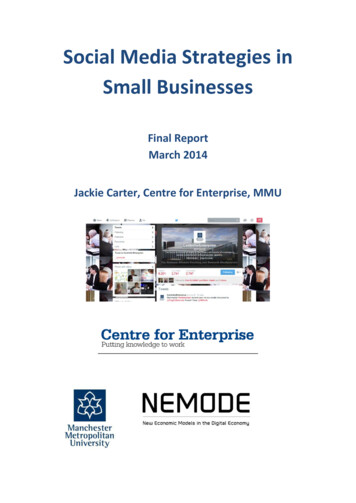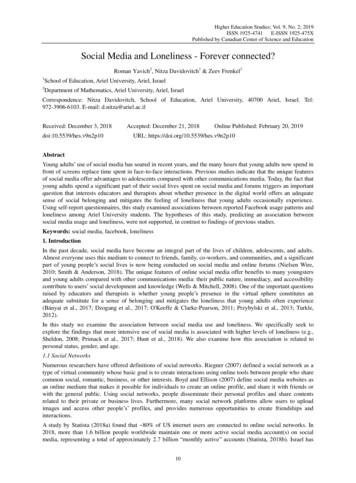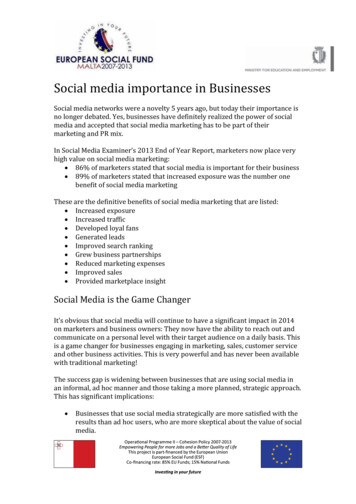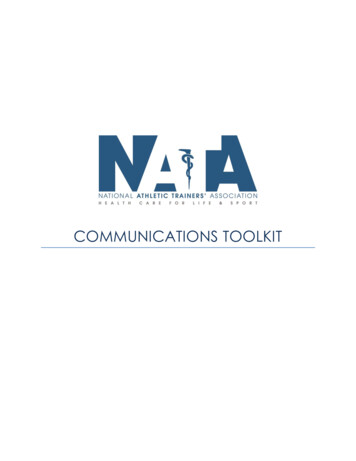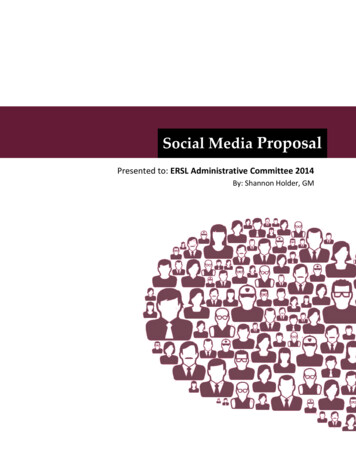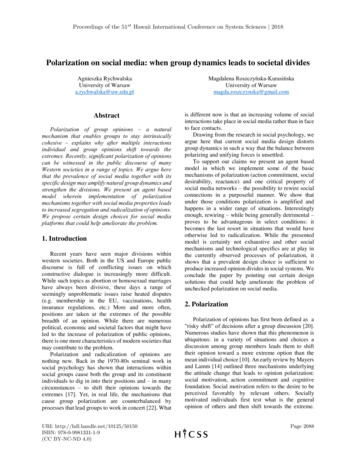
Transcription
Proceedings of the 51st Hawaii International Conference on System Sciences 2018Polarization on social media: when group dynamics leads to societal dividesAgnieszka RychwalskaUniversity of Warsawa.rychwalska@uw.edu.plAbstractPolarization of group opinions – a naturalmechanism that enables groups to stay intrinsicallycohesive – explains why after multiple interactionsindividual and group opinions shift towards theextremes. Recently, significant polarization of opinionscan be witnessed in the public discourse of manyWestern societies in a range of topics. We argue herethat the prevalence of social media together with itsspecific design may amplify natural group dynamics andstrengthen the divisions. We present an agent basedmodel wherein implementation of polarizationmechanisms together with social media properties leadsto increased segregation and radicalization of opinions.We propose certain design choices for social mediaplatforms that could help ameliorate the problem.1. IntroductionRecent years have seen major divisions withinwestern societies. Both in the US and Europe publicdiscourse is full of conflicting issues on whichconstructive dialogue is increasingly more difficult.While such topics as abortion or homosexual marriageshave always been divisive, these days a range ofseemingly unproblematic issues raise heated disputes(e.g. membership in the EU, vaccinations, healthinsurance regulations, etc.) More and more often,positions are taken at the extremes of the possiblebreadth of an opinion. While there are numerouspolitical, economic and societal factors that might haveled to the increase of polarization of public opinions,there is one more characteristics of modern societies thatmay contribute to the problem.Polarization and radicalization of opinions arenothing new. Back in the 1970-80s seminal work insocial psychology has shown that interactions withinsocial groups cause both the group and its constituentindividuals to dig in into their positions and – in manycircumstances – to shift their opinions towards theextremes [17]. Yet, in real life, the mechanisms thatcause group polarization are counterbalanced byprocesses that lead groups to work in concert [22]. WhatURI: http://hdl.handle.net/10125/50150ISBN: 978-0-9981331-1-9(CC BY-NC-ND 4.0)Magdalena Roszczyńska-KurasińskaUniversity of Warsawmagda.roszczynska@gmail.comis different now is that an increasing volume of socialinteractions take place in social media rather than in faceto face contacts.Drawing from the research in social psychology, weargue here that current social media design distortsgroup dynamics in such a way that the balance betweenpolarizing and unifying forces is unsettled.To support our claims we present an agent basedmodel in which we implement some of the basicmechanisms of polarization (action commitment, socialdesirability, reactance) and one critical property ofsocial media networks – the possibility to rewire socialconnections in a purposeful manner. We show thatunder those conditions polarization is amplified andhappens in a wider range of situations. Interestinglyenough, rewiring – while being generally detrimental –proves to be advantageous in select conditions: itbecomes the last resort in situations that would haveotherwise led to radicalization. While the presentedmodel is certainly not exhaustive and other socialmechanisms and technological specifics are at play inthe currently observed processes of polarization, itshows that a prevalent design choice is sufficient toproduce increased opinion divides in social systems. Weconclude the paper by pointing out certain designsolutions that could help ameliorate the problem ofunchecked polarization on social media.2. PolarizationPolarization of opinions has first been defined as a”risky shift” of decisions after a group discussion [20].Numerous studies have shown that this phenomenon isubiquitous: in a variety of situations and choices adiscussion among group members leads them to shifttheir opinion toward a more extreme option than themean individual choice [10]. An early review by Mayersand Lamm [14] outlined three mechanisms underlyingthe attitude change that leads to opinion polarization:social motivation, action commitment and cognitivefoundation. Social motivation refers to the desire to beperceived favorably by relevant others. Sociallymotivated individuals first test what is the generalopinion of others and then shift towards the extreme.Page 2088
Presenting a more extreme opinion creates the image ofhigh self-esteem and therefore is more socially desired.Once the opinion is formed and expressed on thegroup forum the second element of attitude changeactivates – action commitment mechanism. Theverbalization of opinion leads to its enhancement,making it less vulnerable to change in future.Interestingly, even the duration of time spend onthinking on an issue might lead to polarization ofopinion [21]. The last component – cognitive foundation– relates to the cognitive processing of arguments,cognitive rehearsal and acknowledging the novelinformation shared between the members [22].Two branches of research on opinion polarization,one concentrating on the social mechanism – socialcomparison theory [19] – and the second concentratingon the cognitive aspects of dispute – persuasivearguments theory [22] – both report similar effects ofpolarization. In more recent studies, segregation andclustering of opinions have been often found in socialmedia. For example, political blogs link to other blogsof the same political ideology [1, 9]. Individuals preferto read content from authors who present similarpolitical views [11]. Analysis of political disputes onTwitter demonstrates that networks of retweets areclearly segregated into two clusters corresponding to thepolitical left and right [2].While this polarization seems to reflect a naturalgroup mechanism, it is worth noting that social mediadesign may potentially amplify this process. First, thepervasiveness of information on one’s social circleincreases the awareness of the opinions of relevantothers [8]. This might lead to a shift in the individual’sown opinion in pursue of social acceptance, as wasdescribed in the social motivation mechanism ofpolarization.Further, the prevalent design choice of social mediais to broadcast one’s content – including opinionatedstatements – to all social connections at once. Thisvoicing of one’s attitudes constitutes both cognitiverehearsal as well as action commitment – not only arethe views displayed on the forum of the acquaintancegroup but they may also be strengthened by any positivefeedback, such as likes, follows, retweets, etc.Finally, social media enables unprecedentedexchange of information and opinions on a daily basis,allowing even distant individuals to influence oneanother – even if this influence is passive (e.g. beingexposed to content posted by unknown others). Thisintensification of information exchange increases theprobability of encountering the opposite opinion in itsextremes – sometimes even in malicious attempts tospite (e.g. trolling). Exposure to such overstated viewsmay trigger another mechanism that alongsidepolarization can lead to extremization of one’s opinions:reactance – an emotional response to the reduction ofperceived freedom of choice [13]. In the context ofopinion formation reactance would manifest asstrengthening of the opposite opinion to the oneimposed,i.e.,radicalizationofopinions.3. MethodologyTo investigate the possible effects of social mediadesign on polarization dynamics we have chosen theagent based modelling approach. This methodology iswell suited for exploration of macro-level – systemic –effects of individual behavior. While agent basedmodels rarely allow for quantitative prediction, theyoffer a unique opportunity to test possible qualitativeeffects of interventions and solutions that are difficult orimpossible to implement experimentally [3, 4, 5].In an agent based model the researcher specifies thebehavior of elements and the rules that govern theirinteractions and observes the behavior of the wholesystem by describing it with a few aggregate variables(sometimes called order parameters). Agent basedmodels are thus constructed in a bottom-up way – theassumptions concern the individual (micro) level rulesof behavior and the hypotheses are tested at the level ofthe system (macro).Agent based models are used to analyze variouscomplex systems, but one of the most fruitful and richareas of their application has been the modelling ofsocial systems. In particular, opinion dynamics models– such as the one described in this paper – have shown,for example, how the natural drive to follow majoritychoice results in the final distribution of voting [12, 26]or how social influence of opinion leaders allowsminority opinion to survive in the sea of majority [16].While many early opinion dynamics models reliedfully on physics based mechanics [12], recent modelsoften draw from social psychological knowledge toinform the construction of the agents representingindividuals and their interactions [5]. The challenge insuch modelling attempts is to choose the mostappropriate psychological variables for the agents’characteristics and most fitting social contexts for themto interact. On the one hand, the model needs torealistically depict social processes but on the otherhand inclusion of too many variables might render themodel intractable and impossible to interpret.As an example, in the Weisbuch-Deffuant boundedconfidence model [24], which served as the startingpoint for the model presented here, the authors set out toinvestigate how peoples’ tolerance for different viewsaffects the process of social influence and the resultingopinion variation. They observed that individualsusually are not impacted by opinions that are veryPage 2089
different from their own. Therefore if they meet a personthat presents a vastly different view, they will ignore hisor her beliefs and instead will seek influence or advicefrom someone else, whose opinion is within the limitsof the individual’s tolerance for differences.In this model the tolerance for differences is thevariable under scrutiny and all other possible designchoices are kept as simple as possible. Thus, agents havethe theoretical possibility to interact with any otheragent in the system, provided that their opinions arewithin the tolerance limits. The opinions are continuous– ranging from 0 to 1 – and the agents do not have anyother properties that could differentiate them. At eachsimulation step, a pair of agents is drawn randomly (i.e.they “meet” to discuss opinions) and if their views arewithin the tolerance (which is identical for every agent)they shift their opinion slightly towards that of theirinteraction partner.The resulting opinions in the social system of thisdesign depend on the value of tolerance. If the toleranceis high ( 0.3), all agents converge on one opinion (themiddle point, 0.5); when it is low, a few opinionclusters form. The lower the tolerance, the more clustersappear and this relation scales as 1 over 2 times thetolerance value.The basic Weisbuch-Deffuant model is the simplestopinion dynamics model that produces clear divisions inthe final opinion distribution fully accountable to asingle parameter and therefore is well suited forstudying polarization.4. The modelTo test how social media design might impactpolarization process we have designed an agent basedmodel wherein the agents influence each other in a waysimilar to the Weisbuch-Deffuant bounded confidencemodel but also behave according to Myers and Lamm’spolarization mechanisms conceptual scheme [14].Therefore, the agents have an opinion that theybroadcast to others and are influenced by opinionspresented by their social relations – provided that theopinions are within their tolerance for difference. If thisis the case, the agents shift their opinions towards thatof their social links. However, tolerance for differenceis not a static trait of the agents; rather, it changes as theagent’s confidence in her opinion changes: the moreconfident the agent is, the lower her tolerance fordifferent opinions.Drawing from the Myers & Lamm’s concepts, we letthe agents be motivated by social comparison – that is,they seek to be perceived favorably by others.Therefore, their confidence is affected by being inmajority within their social circle. If the agent is inmajority, her confidence grows, if she is in minority, itdrops.Moreover, confidence also changes when the agentis being “heard” by others, following Myers & Lamm’sproposal that verbalization of one’s opinion affects theactor’s attitude. If an agent influences another onewhose opinion is within her tolerance for difference, herconfidence rises.The agents in the model are linked into a network ofsocial relations. Since we interpret the system asoperating on social media, we allow the agents to cut offtheir links and create new connections – that is, to rewiretheir social network. Therefore the agents can, fromtime to time, severe a relation that is far beyond theirtolerance level and instead connect to another person.It is worth stressing that to keep the model tractableit was intentionally rendered non exhaustive – both withrespect to psychological mechanisms of social influenceas well as the technological design solutions.Investigating the effects of e.g. tie strength, powerstructures or algorithmic filtering would requireseparate modelling studies.4.1 Implementation – the basic modelThe modeled social system is composed of N 300individuals, connected by undirected links into a locallyclustered network similar to a small world network(SWN) with an average node degree d 20. The sizeand connectivity of the network were chosen to simulatea medium sized organization or a large acquaintanceclique in which a certain number of meaningfulinteractions (transmitting sufficient amount ofinformation or opinions) per individual can take place ina day. To a certain degree it is possible to emulate asystem of larger size in this model by manipulating thespeed constant and probability constants (as introducedlater) but the model was not intended to simulate a trulybig system (e.g. the whole Facebook network).Polarization has been defined in small group studies andtherefore to simulate much bigger systems a carefulchoice of other mechanisms might be necessary.The agents interact with their link neighbors.Specifically, each agent in the network is characterizedby an opinion (ranging from 0 to 100 and drawnrandomly from a flat distribution at the beginning ofsimulation) and her tolerance for differing opinions thatdefines the range of opinions that can influence her (i.e.form a range around her opinion /- tolerance). Themodel was also run using other opinion distributions atthe start (normal and bimodal, results not presented), butthe flat distribution resembles a discussion on a topic onwhich the individuals do not yet have an opinion.Therefore, it is more apt for the study of polarization ofopinions than normal distribution (possibly,Page 2090
characterizing an already established issue, on whichpeople do not differ much in opinions) or bimodaldistribution (an established issue that has alreadypolarized public opinion).In each simulation step, each agent i randomly drawsone of her social connections j and is influenced by hisor her opinions (if it is within her tolerance range) – sheshifts her opinion Oi toward the opinion Oj of theselected agent by a fraction of the difference of theiropinions:𝑗𝑖𝑂𝑡 1 𝑂𝑡𝑖 2𝑠 (𝑂𝑡 𝑂𝑡𝑖 )Eq. 1where s is the speed constant that affects thevolatility of the influence process, set at 0.1 for allsimulations.The process of social influence here is asymmetrical,resembling the Weisbuch-Deffuant model asimplemented on scale-free networks [23]. That is, onlythe agent i changes her opinion in this mechanisms,while agent j – the source of influence – stays with herprevious opinion. This is important for our intendedcomparisons between real life contacts and interactionon social media. On social media, a user broadcastsinformation for all to see (friends or public, dependingon the settings). Therefore, in the act of “communicatingout” the opinions of the user herself are not affected bythose of her readers – it is only the recipients that can beaffected. Feedback (such as likes, follows, etc.) affectsthe opinions of the broadcaster in an indirect way, asdescribed later.The asymmetry of interactions, as has been noted[23], also helps to relate the power law distribution ofconnections into an asymmetrical influence process –people that are heavily connected (hubs) will have agreater chance of influencing others but will not bethemselves more prone to being influenced, whichreflects the direction of opinion spread in real socialnetworks [15, 18].The tolerance value can be interpreted as thecharacteristics of the topic being discussed in thenetwork. Important issues, e.g. related to the valuesystem, would cause smaller tolerance (i.e. loweracceptance of differing opinions) and trivial issueswould mean bigger tolerance (translating into a widerrange of opinions that can influence an individual). Ashas been described in the previous section, in a fullyconnected network introducing tolerance ranges into theprocess of influence produces varied numbers of peaksin the final distribution of opinions, depending on thevalue of tolerance [24]. In a scale-free network with lowconnectivity ( 4 average links per node) the number ofpeaks and the dispersion of opinions around them aredifferent, but for more connected structures, theyresemble the fully connected case [23]. Therefore, wealso expected similar effects for a SWN with 20connections per node on average.We have used such defined model as the null modelthat provides a baseline for comparisons.4.2. Introducing confidence dynamicsIn the next step we have modified the influencedynamics to add to it the mechanisms of polarizinggroup processes [14]. To that end, we have addedanother agent characteristics, confidence C, rangingfrom 0 to 0.99 and drawn randomly at the beginning ofthe simulations from a normal distribution with mean0.5 and standard deviation of 0.1. This parameterdescribes the self-assurance of an individual in heropinion. The polarization mechanisms of socialdesirability and action commitment (as well as cognitiverehearsal, not modeled), can be thought of as dependingon changing the confidence of opinions within thegroup. This internal trait then can be used as a modifierfor the social influence process.First, since polarization studies show thatstrengthening of one’s confidence depends on assessingwhat is the social norm in one’s group (socialdesirability mechanism), we assume that confidence ofagents depends on their being in majority with regardsto their held opinion. Each agent i assess how many ofher neighbors (countSO) voice an opinion that is withinthe limits of her tolerance – i.e. have similar opinions –and computes what fraction of her total contacts(countN) that group constitutes. She changes herconfidence Ci depending on how much of a majority sheis in (her confidence increases if she is in majority, andit decreases if she is in minority):𝑐𝑜𝑢𝑛𝑡𝑆𝑂𝑖𝐶𝑡 1 𝐶𝑡𝑖 1 3 𝑠 ( 0.5)𝑐𝑜𝑢𝑛𝑁Eq. 2The speed constant is divided by 3 to keepconfidence dynamics slower than opinion dynamics.Second, we let the agents grow confident when theytransmit influential opinions, resembling the effects ofpublicly committing to an opinion by verbalizing it ingroup discussion, as described by the actioncommitment mechanism. Each agent j that has beenused as a source of influence (i.e. was drawn by anotheragent in that agent’s process of social influence),increases her confidence proportionally to the similarityof their opinions (the more similar the opinions are, themore confidence the broadcaster gains; if the follower’sopinion is outside the agent’s tolerance, her confidencedrops):𝑗𝑗𝐶𝑡 1 𝐶𝑡 𝑗𝑗𝑠 (𝑇 (1 𝐶𝑡 ) 𝑂𝑡𝑖 𝑂𝑡 )𝑗𝑡 (1 𝐶𝑡 )Eq. 3where T is tolerance. The speed constant for thisconfidence dynamics mechanism is bigger than forminority / majority related changes to counteract the factPage 2091
that being chosen as influence source is much rarer thanassessment of majority opinion.This behavior in face to face contacts is easy toimagine – a person who is listened to and whoseopinions are repeated among group members wouldgrow more confident. In social media this is also visible,albeit differently. All signs of positive responses forone’s broadcast content (e.g. likes, follows, shares,reposts, comments, etc.) increase positive emotions andare (sometimes desperately) sought after, and can wellpredict whether the author will publish again or not.Finally, to implement the effects of confidence onsocial influence dynamics, we modify an agent’stolerance range TR by multiplying it by the inverse ofher confidence. That is, high confidence results innarrower tolerance limits and low confidence broadensthose limits. A person who is unsure whether his or heropinion is right, would be more prone to seek influencefrom individuals with even very different mindset. Incontrast, a person who is very sure of his or hercorrectness will likely shut out those who broadcastdifferent opinions, even if that difference is not reallybig.𝑇𝑅𝑡𝑖 {𝑂𝑡𝑖 𝑡 (1 𝐶𝑡𝑖 ), 𝑂𝑡𝑖 𝑡 (1 𝐶𝑡𝑖 ) } Eq. 44.2. Reactance implementationIn our next modification we have implemented theprocess of reactance, i.e. changing one’s opinion in thedirection contrary to the influence of others when suchinfluence threatens one’s freedom of choice [13]. In faceto face communication, reactance is visible in rejectingpersistent attempts at influence. For example, a personseeing an obtrusive ad for one brand of soda on avending machine, might choose a different drink – evenagainst her preference – just to maintain a feeling offreedom of choice. The phenomenon of reactance can betraced in social media for example in reactions totrolling attempts (i.e. presenting conflicting and extremeopinions intended to start a dispute or to spite) or whenconfronted with content of a vastly different viewpoint.A recipient of such content or target of trolling usuallygets involved in a heated discussion, voicing opinionsthat are closer to the extreme just to get the upper handin the conflict, even though in normal circumstances shewould not have voiced them. Since verbalizing opinionsis an act of action commitment, reversing opinions totheir previous state might not be possible, especially ifthey receive positive feedback from other involveddisputants.Reactance was implemented in the model as theinverse of social influence. With a small probability(varied from 0 to 0.06) each agent in each simulationstep had a chance of “being reached” by content fromoutside her tolerance range. That is, she randomly drewa link neighbor k with opinion outside her limits(provided she had such neighbors). The agent thenadjusts her opinion to move away from the intolerableneighbor, increasing the difference of opinionsproportionally to the breadth of the difference:𝑖𝑂𝑡 1 𝑂𝑡𝑖 2𝑠 (𝑂𝑡𝑖 𝑂𝑡𝑘 )Eq. 5These two mechanisms of polarization – confidencethat limits the tolerance for different opinions andreactance – and their co-occurrence, provided us threemodels to be tested against the null model: confidence,reactance and both confidence and reactance. To thisspecification we added models that implement oneselected trait of social media - rewiring.To implement the possibility of purposefullyadjusting one’s social connections – rewiring – we allowthe agents to seek for one social contact per simulationstep that is outside the agents tolerance range (if theagent has any such) and whose opinion is the farthestaway from the agent’s. This connection is severed andinstead the agent links to another, randomly selectednode to keep the network density stable. While in termsof network connectivity this moves us from an SWN toa more random connection structure (effectivelyincreasing the probability p of weak ties) it is worthnoting that the connections are not truly random as theyreflect opinion structure.The model was implemented in the NetLogo agentbased modelling platform [25]. The versions of themodel described above (the null model and 7 possiblecombinations of confidence, rewiring and reactance)have been run as separate simulations for 700 time stepsand with 50 repetitions for each combination ofparameters.5. ResultsWhen comparing the implemented group dynamicsmechanisms to the null model we were interested inassessing how segregated are the final opinions, forwhich tolerance levels the segregation happens and howclose to the extremes the opinion peaks are. To assessthis, we have computed Shanon’s entropy on the finalopinion distributions as well as measured the number ofmodes using a statistics developed by [7]:𝑚 1 𝑛 𝑥 𝑥𝑖 1 𝑀 𝑖 2 𝑖Eq. 6where M is the highest frequency in the histogram(i.e. the maximum value), n is the set of bins in thehistogram and xi is the frequency in the bin i.A value of 2.40 is roughly the threshold for bimodaldistributions and a value above 4 describes a distributionwith three or more modes.Additionally, we have inspected opinion histogramsfrom sample simulation runs for increasing values oftolerance and have measured the frequency of extremePage 2092
6Entropytend to form around the midpoint of the opinion scale(i.e. the agents are not segregated into clearly polarizedopinions), there is considerable variation in their size –some opinions are very popular but there are also manyopinions that garner some small following. In sum,introducing confidence into the social influence process,while dividing opinions in a wide range of tolerancevalues, also increases the diversity of opinions andreduces segregation as agents’ growing confidencecounteracts the force to unify on single opinion peaks.10.0Modes measureopinions (10% of the lower and upper opinion range) tosee the degree of radicalization of opinions.The null model resembles the properties of a fullyconnected lattice in Weisbuch-Defuant boundedconfidence model (Fig 1, Fig 2). For values of toleranceabove 23% of the opinion range, the opinions of allagents converge on the midpoint; tolerance below 20%threshold produces two peaks of segregated opinions,that grow increasingly distant as tolerance is decreased(Fig 3). Below the tolerance value of 10% of opinionrange, the number of peaks grows, and the lower thetolerance, the less distinct they eranceModelConfidenceNullConfidence & ReactanceReactanceConfidence & RewireRewireConfidence, Rewire & ReactanceRewire & ReactanceFigure 1. Entropy values for the differentmodels computed on final distributions ofopinions (after 700 simulation steps); eachpoint is an average of 50 simulation runs.Adding the possibility to purposefully rewireconnections amplifies the segregation process in that thesegregation is complete (i.e. all agent’s opinionsconverge on the peaks, with minimal dispersion asreflected in the entropy values, and as can be seen fromthe single bin peaks in the histograms in Fig 3, rightpanel) and in that the range of tolerance values thatgenerate divisions is slightly wider. Specifically, thefirst threshold (that produces two peaks) is at 27%tolerance. In all, rewiring reduces the diversity ofopinions and slightly increases polarization for lessimportant issues (i.e. those characterized by highertolerance for differing opinions).Introducing the mechanisms that change agents’confidence and therefore make tolerance rangedynamical, changes the number of convergence pointsfor agents’ opinions. For all the investigated tolerancevalues, at least two peaks appeared in the finaldistribution of opinions (m value 2.5, Fig 2). However,the peaks are generally smaller and there is a lot ofdispersion around them (Fig 3, left panel). While theyConfidenceNullConfidence & ReactanceReactanceConfidence & RewireRewireConfidence, Rewire & ReactanceRewire & ReactanceFigure 2. Modes measure for the differentmodels computed on final distributions ofopinions (after 700 simulation steps); eachpoint is an average of 50 simulation runs. They scale has been truncated at 10 to increasereadability.Implementation of both rewiring and confidenceresults in typical polarization dynamics. The diversityintroduced by agents’ confidence all but disappears –even at high tolerance levels (i.e. 50% of the opinionrange, Fig 4) clear opinion peaks form and there is littledispersion around them. Rather, all agents converge ontwo opinion bins that are visibly segregated. Thissegregation is also visible at very low tolerance – manyopinion peaks form, but they are very distinct andseparated by gaps in opinion frequencies.When only confidence mechanisms were at play,low values of tolerance produced divisions in opinions,but they were not so segregated and some midpointopinions were present (Fig 3). In all, this shows thatcombining the natural group segregation mechanismswith the possibility to purposefully shape connectionsamplifies the polarization dynamics in a non-linear way.Rewiring alone increased segregation andconfidence mechanisms introduced segregation intoissues whose importance (tolerance) would notnormally warrant it. Together, these two mechanismsPage 2093
produce a social system where opinions are almostperfectly segregated for a very wide range of issues.The mechanism of reactance, when introduced intothe null model by itself strengthens the segregation ofopinions at a wider range of tolerance values, i.e. byproducing clear two peaks for tolerance between 20%and 30% of opinion range (Fig 2). Moreover, for lowervalues of tolerance, where in the null model a few moreor less distinct peaks form, reactance clearly pushesagents to converge predominantly on two opinions only.ModelNullRewiring30020
social media networks – the possibility to rewire social connections in a purposeful manner. We show that under those conditions polarization is amplified and happens in a wider range of situations. Interestingly enough, rewiring – while being generally detrimental



